|
|
|
In-Depth
A League of Their Own
By Ettagale Blauer
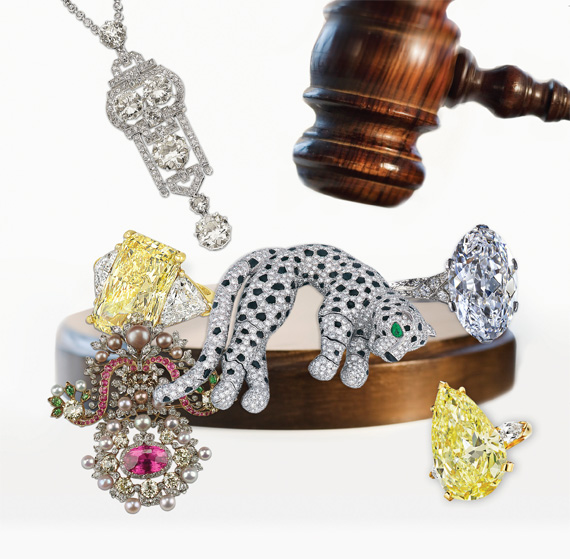
|
| ©Tetra Images/Corbis |
Each auction season, while Christie’s and Sotheby’s garner sparkling headlines, thousands of pieces of beautiful, wearable and signed pieces of jewelry are being offered at the second-tier auction houses. These firms, including three with pedigrees as
old as the megahouses, offer expert advice, viewings, estimates, certification and the whole range of back-office support — just like the big boys — and they do it for jewelry that is affordable to a wide range of customers. Now, with the global reach of the internet, many of these smaller auction houses are selling to, and buying from, a much broader range of customers. They are not only competing for some of the same estates but often winning those estates, thanks to their emphasis on personal service and know-how.
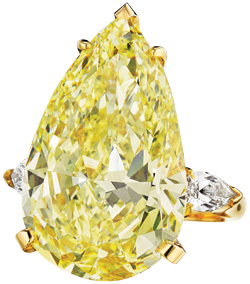
|
| Fancy intense yellow diamond ring. |
PHILLIPS
Name reverted from Phillips de Pury & Company on January 1, 2013, when Simon de Pury retired from the company.
450 Park Avenue, New York, NY 10022
T: 212.940.1283
www.phillips.com
Department head: Nazgol Jahan
Though established in 1796, Phillips is a
mere toddler in holding regular jewelry sales
in New York. It relaunched sales in the city in December 2009. The company has weathered a series of moves — physical, corporate and philosophical — to reach its present emphasis on cutting-edge, contemporary culture. According to Nazgol Jahan, the young department head, “Rather than trying to challenge the top two houses by competing across the board, we decided to focus on certain collecting categories, including contemporary art, photographs, jewelry and design.” The firm targets a younger demographic that attends most of its auctions, not just those for jewelry. “They are ‘collecting’ events,” she explains. Phillips seeks out contemporary jewelry designers whose growth it fosters. It does the same with clientele. “Some of our clients are just beginning to develop their jewelry portfolios,” she adds. “We speak to them like their financial advisers do.” In general, the minimum price for goods accepted for auction by Phillips is $5,000.
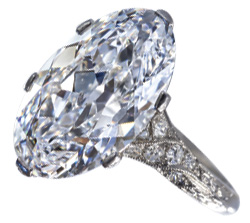
|
| Belle Époque diamond ring, circa 1915. |
580 Madison Avenue, New York, NY 10022
T: 212.644.9001
www.bonhams.com
Department heads: Susan Abeles and
Virginia Salem
While the firm was founded in 1793, Bonhams’ U.S. jewelry department was established in 2004. Bonhams jewelry experts Susan Abeles and Virginia Salem acknowledge the competition to get estates. Abeles says, “We are very competitive; we are willing to travel to get goods, and then to travel the highlights to our offices in San Francisco and Los Angeles, as well as
New York. In a recent estate offering, the diamonds were also sent to London
and Hong Kong.” Bonhams considers itself “more international” than the other
second-tier houses.
The firm offers a high volume of merchandise, including monthly sales of 250 lots,
each with a value of approximately $500. Many lots are sold without a reserve. Salon
sales are held four times a year, with merchandise typically ranging from $1,000 to $5,000 in price. Fine jewelry sales include period and designer names that range in price upward to $1 million and more. The internet has expanded Bonhams’ reach dramatically and though the firm conducts its auctions in front of live audiences, much of the bidding — and buying — is done on the internet and on the phone.
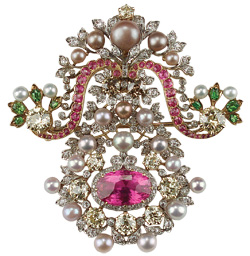
|
| Paulding Farnham for Tiffany & Co. |
63 Park Plaza, Boston, MA 02116
T: 617.350.5400
www.skinnerinc.com
Jewelry vice president: Gloria Lieberman
Skinner, a traditional auction house, has
carved out a prominent niche in its geographic area and with it, a dominant role in the sale of estates of prominent figures from that region. Veteran department director Gloria Lieberman says, “The other houses are dealing with bigger dollars and great prominent estates and big diamonds. We will get people with provenance, famous people who lived in the New England area. We have created markets for jewelry like Arts & Crafts makers from the
Boston area.”
Lieberman emphasizes presentation. “When you open up an auction catalog, you should feel you are walking into an antique store,” she says. But, she adds, “The internet is a game changer. It benefits us and the collectors. They don’t have to go only to the big houses” and they can view auction catalogs online. Who gets left out? “The dealers. In the past, they were buying from regional auction houses and taking goods to the bigger market.” Now the auction houses and the buyers more easily find each other, online.
The firm’s usual minimum is $1,000. “You have to be concerned with the value of gold,” says Lieberman. “You cannot price under the gold price.”
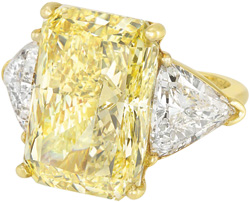
|
| Diamond and platinum ring. |
175 East 87th Street, New York, NY 10128
T: 212.427.2730
www.doylenewyork.com
Head of department: Ann Lange
Tucked away on a side street on the
Upper East Side of New York City, Doyle’s, founded in 1962, looks like a cozy neighborhood shop, but its unpretentious appearance is misleading. The firm specializes in midrange jewelry with an emphasis on fine-quality goods with a refined look, according to department director Ann Lange. “Trust has always been an important part of the business,” she notes. A recent upgrading of the firm’s catalogs was designed to enable it to compete with the better-known houses. “In the past seven years, we have changed our catalog presentation to make the catalog more like personal shopping,” she says.
While much of the merchandise falls into the $500 to $10,000 range, Lange notes
that “We recently sold a turquoise Schlumberger piece for $60,000.” The firm shops its goods internationally and recently traveled to the Maastricht Fair in The Netherlands with
a particular estate that generated “a tremendous buzz. This put us on the map.” The firm went online with its jewelry sales in 2012 but Lange says, “When there’s lots of buying
in the room, it’s lots of fun.”
Two newcomers to the jewelry auction scene, Heritage Auctions and Joseph DuMouchelle, began as singular niche firms. Both hold their sales in public venues.
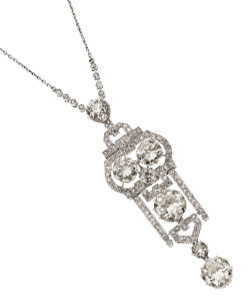
|
| Art Deco diamond and platinum pendant. |
3500 Maple Avenue, Dallas, TX 75219
T: 800.872.6467
www.ha.com
Department head: Jill Burgum
Heritage’s founders, Steve Ivy and
Jim Halperin, began 40 years ago as purveyors of coins and currency in Dallas, Texas. The jewelry department was part of an explosive expansion a dozen years ago. Jill Burgum arrived seven years ago to head the jewelry department, one of 33 specialty areas now under the Heritage umbrella. Much of the company’s growth derives from the power of the internet. “We have an enormous website,” Burgum notes, with a “permanent auction archive. You can look up any piece we’ve sold.” Headquartered in Dallas, the firm has U.S. offices in Beverly Hills, New York and San Francisco. Its New York auctions usually take place at Fletcher-Sinclair Mansion,
2 East 79th Street, at Fifth Avenue.
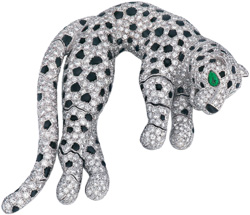
|
| Cartier |
580 Fifth Avenue New York, NY 10036
T: 800.475.8898 212.740.7600
www.josephdumouchelle.com
Company president: Joseph DuMouchelle
Joseph DuMouchelle is the only one of the second-tier auction houses that focuses almost exclusively on gems and jewelry. DuMouchelle, who says he grew up in the auction business in Detroit, earned a Bachelor of Arts degree (BA) and then studied at the Gemological Institute of America (GIA) for his graduate gemologist (GG) degree. Although he describes the firm’s main location as the 580 Fifth Avenue building
in New York City, sales are held offsite, most recently at the Plaza Hotel. “Traditional
sit-down auctions” are not as important, he notes, since the advent of the internet and
“85 percent to 90 percent of the sales in the company’s most recent auctions took place outside the physical auction venue.” While sales were formerly keyed to U.S. holidays, the firm’s online exposure has led to significant growth in the international market. The firm holds seven sales a year; the usual minimum value of each lot is $10,000. The emphasis is on signed goods, mainly from estates. Like the other houses, DuMouchelle has seen a major shift to online selling. “Years ago, we printed 10,000 catalogs for each sale. Today, hundreds of thousands of people can take part. Sellers don’t have to wait.” When someone wants to sell goods, DuMouchelle can put a sale together for them and get it online immediately, rather than waiting for a sit-down sale.
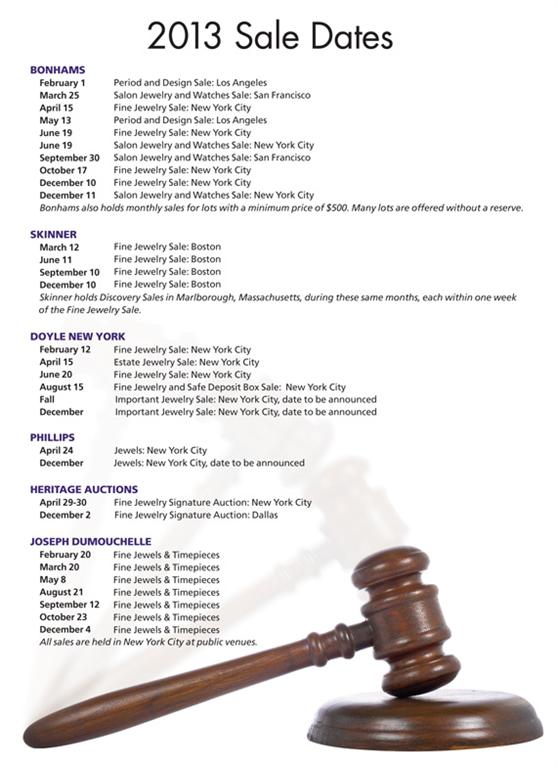 Article from the Rapaport Magazine - February 2013. To subscribe click here.
|
|

|
|